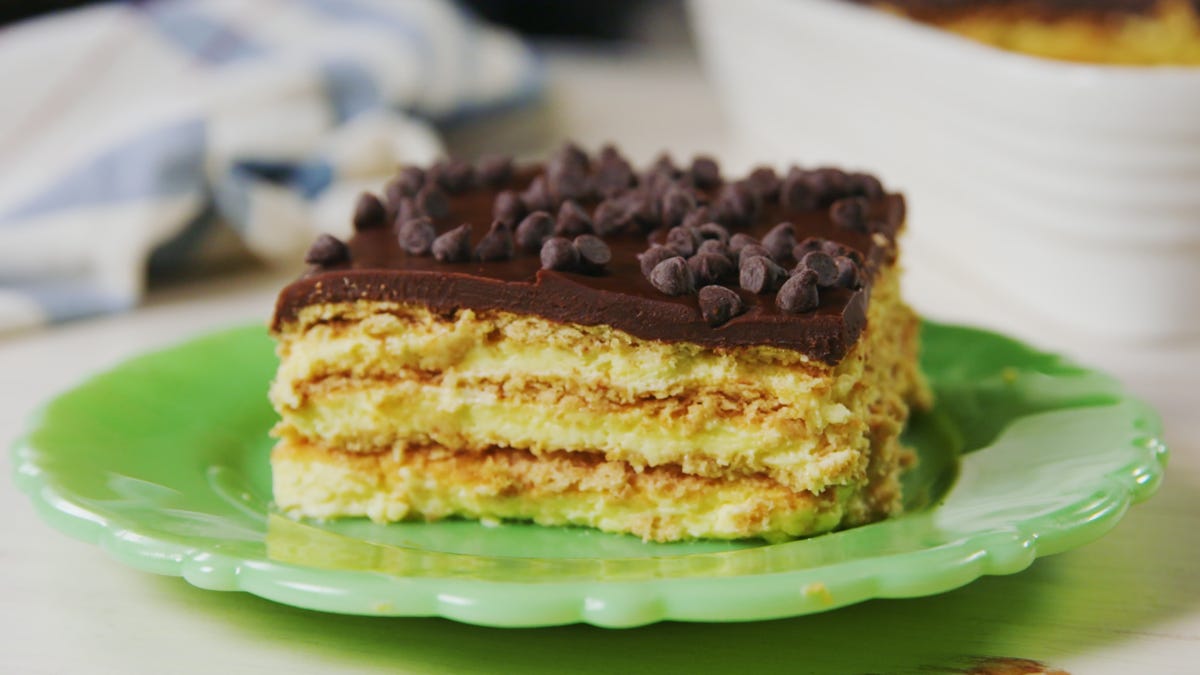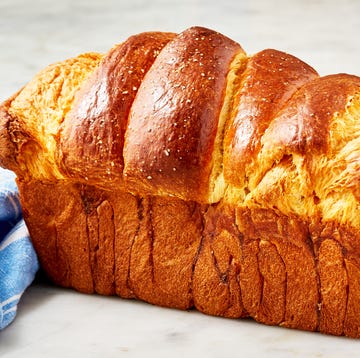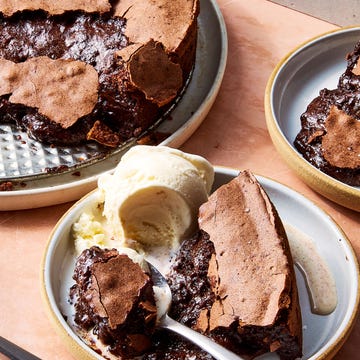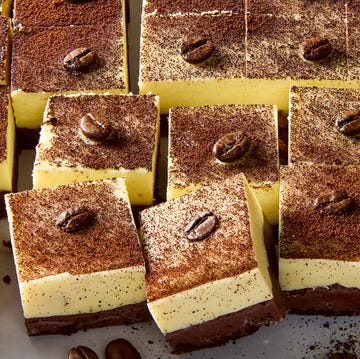

Yields:
10 serving(s)
Prep Time:
45 mins
Total Time:
2 hrs
Sometimes the dessert craving hits us out of nowhere, and we’re looking for a quick, easy treat to whip up within an hour: snickerdoodles, cornflake cookies, maybe even a chocolate-covered strawberry. But sometimes, we’re in the mood to whip up something fancier: a dessert that might take a little more planning ahead, but is an absolute showstopper. In moments like these, we’re looking to this Napoleon cake.
Layers and layers of flaky puff pastry and homemade vanilla pastry cream, covered with more pastry cream and puff pastry crumbs and decorated with fresh fruit. Elegant in its simplicity, this creamy cool dessert is summer at its best. It might take a little more time and some thinking ahead (we recommend refrigerating overnight for the best eating experience!), but it is SO worth it.
Read on for more tips on making this stunning dessert. And if you’re looking for more desserts, check out some of our favorite layer cakes.
What is Napoleon cake? Is it the same thing as a Napoleon dessert?
Originating in Russia, the Napoleon cake is composed of many layers of puff pastry with a whipped pastry cream filling and encrusted with more pastry crumbs. After assembling, the cake is chilled overnight to allow the pastry layers to soften and absorb some of the cream, similar to the classic American icebox cake. The Napoleon cake takes inspiration from the French mille-feuille or Napoleon dessert, which is also traditionally made with layers of puff pastry and pastry cream, but it isn’t the same dessert. While a Napoleon dessert has just a few thicker layers of pastry and cream, the Napoleon cake traditionally has at least 8 very thin layers of pastry spread with cream—and sometimes as many as 12! It’s more similar to a crepe cake than it is to a traditional Napoleon dessert.
What is the filling for Napoleon cake?
Traditionally, Napoleon cake is filled with pastry cream: a cornstarch-thickened custard that’s cooked on the stovetop until it becomes thick and pudding-like. We’ve stuck pretty close to the classic in this recipe, with the addition of whipped cream, which we fold into the chilled pastry cream to lighten it up. The result is a light, creamy, luscious filling, perfect for sandwiching between those puff pastry layers.
What’s the best way to separate eggs?
There are tons of ways to separate eggs. Some crack the egg into their hands and spread their fingers apart just enough to let the yolk run through, while others transfer the yolk carefully between shells until the egg white slips down into a waiting bowl. These methods seem a little perilous to us; it’s easy to puncture the yolk on a jagged edge of an eggshell, and using one hand to crack an egg into the other sounds like a sure recipe for disaster. We suggest separating the whites by cracking the eggs directly into a strainer. Alternatively, you can crack the whole eggs into a bowl and scoop out the yolks with a spoon. These are the easiest, cleanest ways to ensure a successful separation!
What do I do with the extra egg whites?
That’s always the million-dollar question! Fortunately, there are tons of egg white recipes, so you can put your leftovers to good use. Make these flourless fudge cookies or try your hand at a pavlova…you can never have too much dessert, right?
What temperature should my puff pastry be?
When rolling out puff pastry, it’s important to keep it cold…but not too cold. It’s a temperature balancing act: You don’t want the fat in the pastry to melt, spoiling those beautiful flaky layers, but you also don’t want the fat to be so cold that you can’t roll it out. Our suggestion? Let your puff pastry sit out at room temperature for about 5 minutes before rolling it out, and once you start rolling, work quickly so you handle it as little as possible. And once your pastry is rolled out and you’ve cut your rectangles, refrigerate them unless you’re planning to bake immediately. You’ll get the best results if they stay chilled until they hit the heat of the oven.
How long do I bake my puff pastry?
It’s always important to cook pastry to a deep golden brown (color equals flavor!), but in this recipe, it’s especially important. If the innermost layers of puff pastry aren’t completely dried out, they will get gummy when sandwiched with the pastry cream filling instead of just softening gently. You’ll wind up with a dessert that’s hard to cut, hard to eat, and not nearly as tasty as it can be.
Made this? Let us know how it went in the comments below.
Advertisement - Continue Reading Below
Ingredients
Pastry Cream Filling
- 8
large egg yolks (112 g.)
- 1/2 cup
(56 g.) cornstarch
- 1/2 tsp.
kosher salt
- 1 cup
(198 g.) granulated sugar, divided
- 4 cups
(946 mL) whole milk
- 4 Tbsp.
(1/2 stick; 57 g.) butter, room temperature
- 4 tsp.
vanilla extract
- 2 cups
(473 mL) heavy cream
Puff Pastry Layers
- 2
(1-lb.) boxes puff pastry, thawed
All-purpose flour, for rolling
Assembly
Mixed fresh berries, for serving
Directions
Pastry Cream Filling
- Step 1In a large heatproof bowl, whisk egg yolks, cornstarch, salt, and 1/2 cup (99 g.) granulated sugar.
- Step 2In a medium pot over medium heat, heat milk and remaining 1/2 cup (98 g.) granulated sugar, stirring, until sugar is dissolved and milk is steaming. Whisking constantly, pour half of hot sugar milk into egg mixture. Pour milk-egg mixture into pot and cook over medium heat, stirring constantly, until pastry cream boils and thickens to a pudding-like consistency, 1 to 2 minutes. Cook, stirring, 1 minute more, then remove from heat. Stir in butter and vanilla.
- Step 3Pour hot pastry cream onto a rimmed baking sheet and cover with plastic wrap, pressing directly onto pastry cream. Refrigerate until cold.
- Step 4In a large bowl, whisk heavy cream until stiff peaks form. Transfer cold pastry cream to another large bowl and stir until smooth. Stir one-quarter of whipped cream into pastry cream until combined. Using a rubber spatula, carefully fold in remaining whipped cream. Refrigerate pastry cream filling until ready to assemble.
- Step 5Make Ahead: Pastry cream (without whipped cream folded in) can be made 3 days ahead. Keep chilled.
Puff Pastry Layers
- Step 1Preheat oven to 400° and line a rimmed baking sheet with parchment paper. Remove 1 sheet of puff pastry from refrigerator. On a lightly floured surface, roll out to a 13"-by-13" square. Cut square into 2 rectangles, transfer to prepared baking sheet, and prick all over with a fork.
- Step 2Bake, rotating sheet and flipping pastry halfway through, until deeply browned and crisp, 12 to 15 minutes. Transfer to a wire rack and let cool completely.
- Step 3Repeat with remaining 3 sheets of puff pastry for a total of 8 pastry rectangles.
Assembly
- Step 1Stack 7 puff pastry rectangles on top of one another; set remaining 1 rectangle aside. Using a serrated knife, trim edges so rectangles are a uniform shape; reserve crumbs.
- Step 2Arrange 1 puff pastry rectangle on a platter. Spread 1 cup pastry cream filling over puff pastry rectangle; top with a second rectangle and spread with 1 cup filling. Repeat layering with 5 remaining rectangles and 5 cups filling. Cover sides of cake with remaining filling.
- Step 3Loosely cover with plastic wrap and refrigerate cake at least 4 hours or, preferably, up to overnight.
- Step 4Before serving, crush reserved puff pastry rectangle to fine crumbs, add to reserved crumbs, then press into sides and top of cake. Top with berries.
Advertisement - Continue Reading Below
Advertisement - Continue Reading Below
Advertisement - Continue Reading Below












